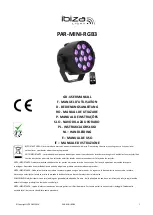
4-14
proceed with this test; find the failed components
and repair them.
After successful testing of the VSENSE circuit,
connect a 500 ohm 100W load resistor to the
unit's RF outputs. Select Pure Cut and slowly
increase the power setting while monitoring
TP15. The dc voltage at TP15 should increase as
power increases, but should not exceed 5.0 volts
at full power.
Units that have passed the troubleshooting steps
so far should be checked for properly oriented
diodes, mismarked resistors, and correct divider
voltages. If the unit has passed these BVG checks,
then the problem is likely elsewhere.
4.5.4 Waveform Generator Troubleshooting
Disconnect A4P3 before checking a suspect
Waveform Generator (WFG). Enter the dI2
mode (see section 4.5.2). Check that a 2.5 Mhz
clock appears at A3TP19. Select a power setting
and mode that corresponds to the photos in
Figure 3.5 and confirm the waveforms are similar
to that at TP10 (use TP20 to trigger the oscillo-
scope to get comparable results). If they are not,
suspect one of A3U13-U18 as being bad.
Another problem could be in the waveform select
lines WV0-WV7.
4.5.5 Aspen Return Monitor (A.R.M.)
Troubleshooting
The overall functionality of the A.R.M. circuitry
may be checked by selecting DUAL FOIL in Run
Mode and connecting an accurate decade resis-
tance box or selected resistors to either of the
Return Electrode Jacks on the output panel. If
the Resistance Indicator vs. resistance appears to
match Table 3.1, then the circuitry may be
assumed to be operating properly.
If this test passes, but the unit still declares unac-
countable Return Fault in operation with the
ESU activated, interference from electrosurgical
current is the likely cause. Check the A4T5 shield
lid for good electrical and mechanical contact
with the shield cup, and capacitors A4C71 and
C72 for proper value and connection. Also check
bypass capacitors A4C59, A3C25 and low pass
filter capacitor A3C38.
If the Resistance Indicator vs. resistance test fails,
check BVARM at A3TP16 with 10 and 150
ohms connected to the Return Electrode Jacks.
With 10 ohms connected, BVARM should be
+0.88 to 0.98 Vdc and with 150 ohms, it should
be +1.89 to 2.18 Vdc. BVARM should also
match VARM at A3TP17 to within 10 mV dc. If
this test passes, then the trouble is most likely in
the DAC A3U19 or A.R.M. comparator circuitry
around A3U23. Note that a faulty DAC is also
likely to cause HLP-5 Alarms.
If the VARM vs. resistance test fails, check the dc
current source by connecting a dc milliammeter
from A3TP17 to ground. The meter should read
from 0.49 to 0.51 mA.
If VARM test reads near zero and the dc current
is low, repeat the current test with A3J2 discon-
nected to eliminate a possible VARM short to
ground in the A6W4 harness or on the A4 PWB
and shorted transistors A4Q5 or Q6.
With the Return Electrode Jacks open-circuited,
check the waveforms on the A.R.M. oscillator
collectors, A4Q5 and Q6. They should appear as
(in Figure 3.2) frequency of 34.5 - 38.1 KHz. If
the frequency is too high, A4C33, 34, 71 or 72
may be open. If the circuit is not oscillating and
VARM is 0.6 - 0.8 Vdc, check the feedback resis-
tors A4R19 and R20, transformer A4T4 for
opens or shorts and transistors A4Q5 and Q6 for
opens. If the circuit is oscillating at the correct
frequency but VARM does not respond to resis-
tance changes, check the circuitry from the sec-
ondary to A4T4 to the Return Electrode jacks for
shorts or open circuits.
4.5.6 Power Amplifier Troubleshooting
The first step in troubleshooting a Power
Amplifier (PA) is to remove all PA collector and
base fuses (check the fuses as you remove them
and note if any of them are blown). This will pre-
vent possible secondary failures in the PA due to
overload.
Use a VOM to check for shorted bipolar power
transistors, power MOSFET, and snubbing net-
works. Check to see that diodes are functional.
Check TP15 for approxi50 Vdc and
TP5 for +12 Vdc.
Summary of Contents for sabre 180
Page 1: ...Service Manual...
Page 6: ...This page intentionally left blank...









































